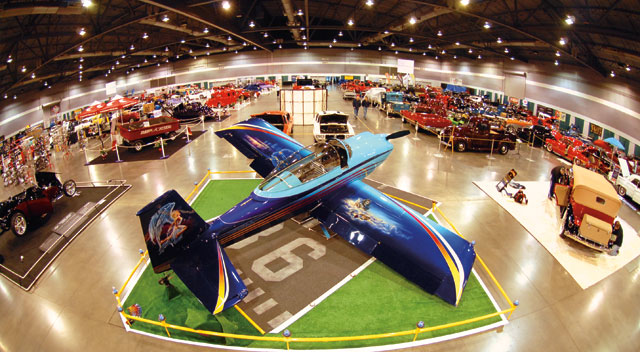
‘American Angel’
A beautiful ambassador for general aviation
Eugene, Oregon’s John Stahr, an airbrush artist, is known for painting intricate works of art on everything from R44 Raven helicopters to Global Express business jets. His nose-to-spinner paint designs are always crowd pleasers, and his RV–8, American Angel, is fast becoming an ambassador for GA.
Stahr suggested displaying his aircraft at the 2011 Portland Roadster car show. With his brother, Mike, Stahr designed an aviation-themed 20-foot-by-20-foot island booth for the show. The stream of people admiring Stahr’s RV–8 was steady. “Most of the questions were about performance,” Stahr said, “They asked how fast it was, and where did I land it to get in the show.”
The American Angel’s paint design is universally appealing, especially to veterans. “The art on the left wing honors three fallen Blue Angel Hornet pilots, while the right wing was painted in memory of my wife, Patti’s, father—who flew P–38s in World War II.” The airplane also has a larger-than-life red, white, and blue angel spreading her wings on the underside of the fuselage and across both wings. Stahr’s wife was the model for the artwork.
“I like the ramp magnet effect this airplane has, and the closer people get, the more interest they take. I look forward to introducing people to flying in my custom-built airplane, completing lots of Young Eagles flights, and showing up at plenty of airport pancake breakfasts,” Stahr says. —Dan Pimentel
See more of John Stahr’s aviation paint designs at www.artisticaviation.com.

Second impulse
Second Solar Impulse going from A to B
As this was written a sun-powered airplane called Solar Impulse A was preparing to return from Morocco to its base in Switzerland, where construction of Solar Impulse B has started. The prototype was meant only to test night flying without fuel, but it ended up in Morocco and provided valuable information for the next trip—a series of legs that will circle the globe. The single-cockpit prototype, with a wingspan exceeding 200 feet, is powered by four 10-horsepower electric motors that get their power from rechargeable batteries. It descends by night—not to the ground, hopefully—and climbs by day. The new model, undergoing main spar testing, will first fly in the spring of 2013 and circle the world in 2014.
Destinations in the United States for the big flight are under review. They must have something to do with renewable energy.
Who thought it up? Swiss psychiatrist Dr. Bertrand Piccard is the son of Jacques Piccard who, with Don Walsh, made history by diving their Trieste sub to 6.8 miles under water in the Marianas Trench. Bertrand Piccard made the first nonstop balloon trip around the world in the Breitling Orbiter in 1999.
did you know? If the Solar Impulse faces a headwind greater than 38 knots, it will be blown back to its departure point. That actually happened on a first attempt to cross Morocco. —Alton K. Marsh
Pedal chopper
Reaching for the quarter-million-dollar ring
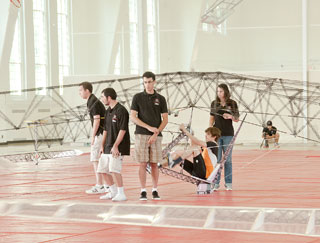
University of Maryland engineering students have pedaled furthest of any college trying to win a $250,000 prize for human-powered helicopter flight. In June they topped their 2011 record by 400 percent, staying a few inches off the floor of a gymnasium for 50 seconds.
The first school to reach a full minute—and also a brief height of nearly 10 feet—will win the American Helicopter Society’s Igor I. Sikorsky Human-Powered Helicopter Competition.
Some of the tests were shorted when Gamera II—that’s a terrible turtle that starred in old Japanese horror flicks and is not unlike the school mascot—kept bumping into walls. That caused rotor damage and required a few hours for repairs. The angry turtle was piloted by Ph.D. candidate Kyle Gluesenkamp. If it had been a nice turtle, maybe it wouldn’t have tried to tear down the armory. —Alton K. Marsh
What’s it look like?
- A big X with a rotor on each end
Gamera II
- Weight: 71 pounds
- Size: A little larger than a Boeing 737
- Number of rotors: 4
- Rotor rpm: 20
- Horsepower required from human: 0.62
Powder puff pilots
College pilots make strong showing in Air Race Classic
Once called the Powder Puff Derby, now the Air Race Classic, this race can trace its roots back to 1929. This year the winners were Texas pilots Dianna Stanger (3,400 hours) and Victoria Holt (5,500 hours) flying a Cirrus SR22, but they beat a collegiate team by less than three-tenths of a point.
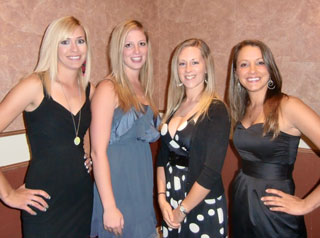
Danielle Erlichman and Marisha Falk, of Embry-Riddle Aeronautical University’s Daytona Beach, Florida, campus not only came in second, they also got an award for being first among the college women fliers. They flew a Cessna 172S. Their Embry-Riddle Prescott teammates, also in a 172S, did well too. Coming in ninth overall, Marlese Wessel and Kristine Anthony were the third-place winners among collegiate aviators. Second place in the collegiate category was taken by Nicole Lordemann and Tonya Hodson of Kansas State, who came in eighth against all competitors.
Things you didn’t know
- The 1929 Women’s Air Derby was named the Powder Puff Derby by humorist Will Rogers, who claimed he saw contestants powdering their noses prior to departure.
- Astronaut Eileen Collins took 1929 winner Louise Thaden’s cloth flying helmet into space.
Test Pilot By Barry Schiff
- From reader Tom Haines: Why is the action of moving an airplane on the ground under its own power called taxiing?
- An airplane with a normal glide speed of 75 knots glides 10,000 feet forward for every 1,000 feet of altitude lost (a glide ratio of 10:1). If a pilot disposes of 1,000 pounds of payload while gliding at the same airspeed, the glide ratio would:
a) increase.
b) decrease.
c) remain the same.
d) cannot be determined. - What U.S.-built, twin-engine airplane was or has been in continuous production longer than any other?
- True or False: As a pilot proceeds north, circles of latitude become smaller.
- During World War II, small black bombs (nose markings) were painted on the nose below the cockpit to denote how many bombing missions a particular bomber had completed. What was the significance of nose markings that were small black camels?
- If a pilot were to inadvertently squawk 5200 on his transponder, he could be mistaken by an air traffic controller for a:
a) remotely piloted vehicle.
b) pilot who has declared "minimum fuel."
c) truck carrying hazardous material.
d) ship at sea. - From reader John Schmidt: Whose personal airplanes were named Immelman I, Immelman II, and Immelman III?
- A pilot flying close to and above a stratified cloud layer sees the sharply defined shadow of his aircraft completely encircled by a rainbow-like ring. This phenomenon is called a _______.
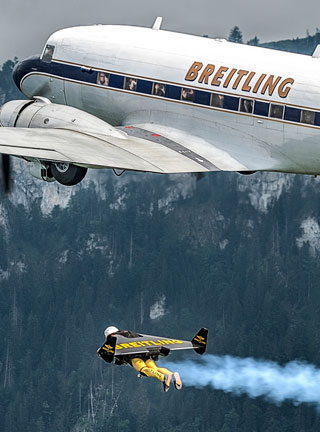
Flying with Jetman
Sounds like a comic book character, but given the number of times Yves Rossy has flown with a wing on his back, it seems routine. Four jet engines intended for large model airplanes powered him for six or seven minutes alongside a Douglas DC–3 carrying Breitling employees during his latest adventure. Breitling is his main sponsor. —Barry Schiff
Fun facts
- Engines: German-made JetCat turbine engines, 45 pounds thrust, $5,200 each, 25-second autostart
- How does JetCat feel about it? “It’s for him and him only.”—Bob Wilcox, JetCat USA
- Total fuel: 8 gallons, kerosene and turbine oil
- Weight: (loaded with fuel and smoke oil)—121 pounds
- Speed: 107 knots; descent, 161 knots
- Wingspan: 10 feet
- Flight controls: throttle, head, arms, legs
Tiny Florida company makes huge China deal

Cessna Aircraft and Embraer may have their mega-deals with China, but so does the 14-person Team Tango company in Williston, Florida. Some people just know how to seize an opportunity. When Dennis Moellman, the company president, heard about China’s plan to open lower airspace to general aviation, he began writing proposals in late 2010 for a fully certified airplane (in the People’s Republic of China, at least) based on his kit models. He has 31 two-seat, 180-knot Tango aircraft sold with 18 completed and flying—and 11 Foxtrot four-place, 190-knot kits out there, with two flying. A firm in China will certify and build the Tango model and a new one, the Rapier, based on the Foxtrot but intentionally made wider than a Cirrus. “We’re taking a chance. We’ll see if things work out,” Moellman said. He will become the distributor for the aircraft in the United States, once certification details are worked out. Moellman was in China looking for an interested company when he learned another Chinese company was in Florida looking for him. They had found him on the Internet. Opportunity literally came knocking, and Moellman was ready. —Alton K. Marsh
The agreement
- Who: It’s with the THXH Hubei Aviation Company.
- Where: Xiangyang (shen YANG), Chinese Province of Hubei.
- When: Soon. The factory is under construction in a new industrial park.
Why it may work
- The Chinese government is very supportive of certification efforts, and the factory is already under construction.
The secret ingredient
- Dennis Moellman is familiar with international negotiation through past work in the intelligence community.
Summit 2012
Join the Parade of Planes
Come be part of AOPA Summit by volunteering October 10 to 13 in Palm Springs, California. Help with aircraft parking and display, car and crowd direction, or the Parade of Planes and qualify for free admission to AOPA Summit.
Visit the website for details.
iPhone becomes a HUD
A head-up display that’s got to be seen to be believed
The iPhone hasn’t become an indispensable flight instrument yet, but that may be changing. Hilton Software, maker of WingX Pro7 (a leading flight planning and EFB program), has converted the iPhone into a combined attitude indicator and head-up display (HUD) that includes synthetic vision—and has got to be seen to be believed.
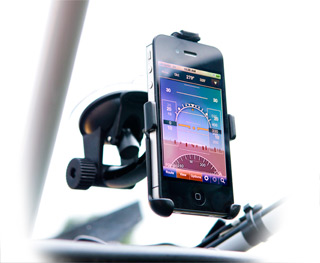
When linked (via WiFi) to a Levil Technology attitude and heading reference system (AHRS), the glareshield-mounted iPhone accurately depicts GPS-derived altitude and groundspeed as well as pitch and bank, with no attitude limitations. With the Levil unit connected to the airplane’s pitot/static system, it shows indicated airspeed and barometric altitude. During approach and landing, the airport and runways appear as they do in real life, and future versions are likely to include highway-in-the-sky symbols, too.
And while the iPhone’s big brother, the iPad, has taken the aviation world by storm, the iPhone hasn’t—even though it addresses some of the iPad’s most glaring aviation shortcomings. The iPhone screen, for example, is far brighter, easier to read, and less reflective in sunlight. And the iPhone’s smaller size makes it simple to mount in a confined cockpit. (I used a suction-cup mount from Flyvie.)Best of all, the iPhone can be placed in the pilot’s normal field of view without blocking large segments of sky. It also can be mounted in a horizontal (landscape) or vertical (portrait) view. And most pilots won’t have to rush out and buy iPhones since they are practically physical appendages already.
A portable device like the iPhone can’t be FAA certified as a flight instrument, and it’s not meant for flying in the clouds. But the iPhone’s high-resolution display is clear and easy to read, and when used in combination with traditional avionics, it can improve pilot situational awareness.
Other firms (such as Sagetech) are developing solid-state AHRS units that can wirelessly transmit to a broad range of smart phones, tablet computers, and other avionics. And Aero Visions International of Carson City, Nevada, offers its “iHud” for the iPhone as an app, or connected to a Levil AHRS (without synthetic vision).
It’s easy to imagine such iPhone tools being used in aviation applications as varied as helping aerobatic pilots precisely hit their 45- and 90-degree up and down lines, or keeping VFR pilots oriented on hazy days and moonless nights, or during electrical failures when aircraft avionics may be powered down. —Dave Hirschman
Redbird goes low tech
A computerized Cub sim
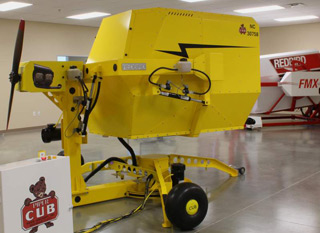
In honor of the Piper J–3 Cub’s seventy-fifth anniversary this year, Redbird Flight Simulations has come up with—you guessed it—a realistic, full-motion, Cub simulator.
The sophisticated, computer-controlled, electronic box with a 180-degree wraparound view mimics the low-tech Cub’s flight characteristics, and some of its ground mannerisms, too. To start the simulation, for example, someone needs to manually spin the propeller on the outside of the box. Contact!
“We built this as a fun, one-off project in honor of the Cub and we wanted to have it at Oshkosh to celebrate the anniversary,” said Todd Willinger, Redbird CEO. “If someone wants to buy it, we’ll be glad to make more. But this was something we are doing to mark an aviation milestone.”
The yellow-painted Cub sim is based on Redbird’s MX-2 model, which typically sells for about $50,000.
“I don’t know exactly what the price for a Cub sim would be,” he said. “But I’m guessing it would be a lot less than a new Super Cub.” —Dave Hirschman
AirVenture 2012
- Cessna Aircraft is removing its 162 Skycatcher from the Light Sport Aircraft category into the Primary Aircraft category. The manufacturer made the move to help speed up certification of the single-engine piston aircraft in Europe and the rest of the world. A Cessna 182 powered by a 230-horsepower Jet-A-burning piston engine will be available in the second quarter of 2013. The thinly masked Cessna 182 Turbo NXT on display drew widespread attention.
- Dynon is offering a battery- powered attitude indicator with internal GPS called the Dynon D1 Pocket Panel.
- Continental Motors will obtain FAA certification this year on the first of what the company promises will be a full line of diesel aircraft engines ranging from 150 to 350 horsepower.
- Avidyne Corp. provided additional information about its IFD440 FMS/GPS/NAV/COM. Designed as a plug-and-play replacement for Garmin GNS430-series navigators, Avidyne says the IFD440 can reduce installation cost and downtime for customers who want to add a touch-screen display or who are upgrading avionics to obtain Satellite-Based Augmentation Systems/Localizer Performance Vertical Guidance (SBAS/LPV) and Automatic Dependent Surveillance-Broadcast (ADS-B) capabilities.
- Able Flight has trained a record eight pilots so far in 2012, and six of them received their pilot wings at AirVenture. After two months of intensive training at Purdue University, the six passed their checkrides and are now certificated pilots. They are: Wesley Major of Delaware, Tyrell Rhodes of Illinois, Jason Jernigan of Florida, Matt Sponaugle of West Virginia, Devon Radloff of Wisconsin, and Steven Scott of California.
- Aspen Avionics announced that Connected Pilot, the first in what will be a series of Connected Panel products—providing a wireless link between certified avionics in the aircraft panel and iPads or other portable smart electronic devices—has received technical standard order approval from the FAA.
- Lightspeed Aviation has created FlightLink, a free, downloadable app that allows pilots using Zulu.2 headsets to turn their iPads or iPhones into cockpit recorders. With the app, all communications through the intercom are recorded and available for instant playback and permanent archiving, and recordings may be stored either on the iPad or iPhone or in an iTunes account.
Special offer for student pilots
AOPA offers a special one-time AOPA membership rate of $25 for student pilots. Students receive full membership benefits including 12 issues of Flight Training magazine, access to the Pilot Information Center toll-free help line, flight planning tools, and an opportunity to win a flight training scholarship. Students can enroll online.
Test Pilot Answers
- At the Deperdussin Monoplane School in England in 1911, students practiced "driving" an airplane on the ground as the first step in their training. Such an airplane was not necessarily airworthy and was called the "school bus" or, more often, a "taxi." Use of the verb "taxi" spread and quickly came to mean what it does today.
- (b) Strange but true. Glide speeds provided in pilot operating handbooks apply only at the maximum-allowable gross weight. At lighter weights, glide speed must be reduced to maintain the same glide ratio. Otherwise, glide ratio decreases.
- The Beech Baron has been in production for 51 years, from 1961 to 2012. Runner-up is the Beech King Air, which has been in production since 1964.
- False. This is true only in the Northern Hemisphere. Circles become larger when proceeding north in the Southern Hemisphere.
- Each camel denoted a completed supply mission flown over the Hump (the Himalayan Mountains).
- (d) Large ships at sea often are assigned code 5200. Transponders are not just for airplanes.
- Adolf Hitler used these aircraft (two Junkers 52s and a Focke-Wulf FW 200) and apparently was the first politician to use air travel for campaigning. (His pilot was Hans Bauer.)
- Glory. Much rarer is a double glory, when a second rainbow-like ring concentrically surrounds the first.
Earhart search returns ‘with more questions than answers’
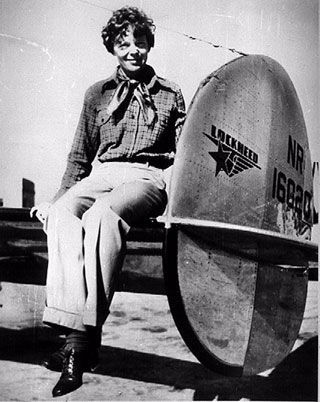
On what would have been Amelia Earhart’s 115th birthday, the expedition—launched in July to investigate possible new evidence of her missing Lockheed Model 10 Electra—returned to Hawaii without conclusive evidence.
The nonprofit International Group for Historic Aircraft Recovery (TIGHAR) announced in March that it planned to conduct extensive deep-water search operations near an uninhabited atoll called Nikumaroro. The aviatrix and her navigator, Fred Noonan, disappeared in July 1937 while trying to locate Howland Island on Earhart’s now-infamous attempt to circumnavigate the globe. TIGHAR has spent 24 years investigating Earhart’s disappearance.
“We’re coming home with more questions than answers,” TIGHAR stated July 23. “We are disappointed that we did not make a dramatic and conclusive discovery, but we are undaunted in our commitment to keep searching.”
The group has volumes of sonar data and many hours of high-definition video to review and analyze before it can be known whether evidence was found. “Due to the limitations of the technology, we were only able to see standard-definition video images during actual search operations,” TIGHAR said. “Now that we’re examining the recorded high-definition video, we’re already seeing objects we want our forensic imaging specialist, Jeff Glickman, to look at.”
The new effort stemmed from a clue spotted in an original negative of a photo of the western shoreline of Nikumaroro (formerly Gardner Island). The negative showed a protrusion from a reef resembling the landing gear of an aircraft.
TIGHAR said “big pieces of airplane wreckage were not immediately apparent, but after 75 years in Nikumaroro’s severe and unstable underwater environment, that is hardly surprising.”
The Discovery Channel planned to air a show on the expedition August 19. —Jill W. Tallman
Astronaut flies west
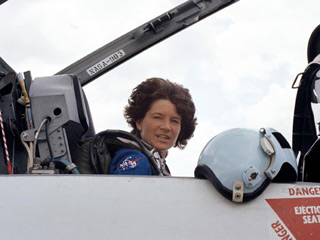
As a physicist, engineer, astronaut, and educator, Sally Kristen Ride blazed a trail and became an icon as the first American woman to fly in space. Ride lost her 17-month battle with pancreatic cancer July 23. She was 61. Ride was one of six women chosen in 1978 for the first coed class of astronaut trainees, and later recalled that the June 18, 1983, flight aboard the Space Shuttle Challenger was a mission that carried extraordinary expectations that were difficult to appreciate at the time. “On launch day, there was so much excitement and so much happening around us in crew quarters, even on the way to the launch pad,” Ride said. “I didn’t really think about it that much at the time, but I came to appreciate what an honor it was to be selected to be the first to get a chance to go into space.”


